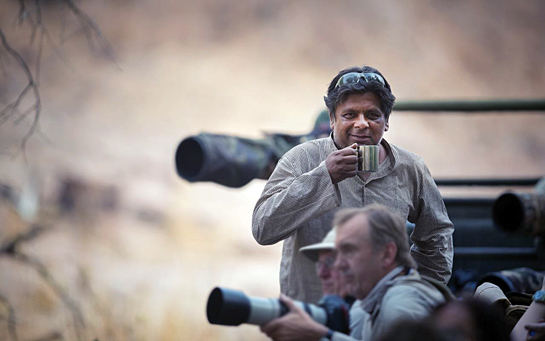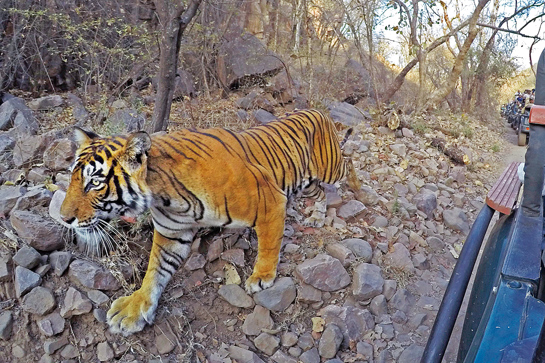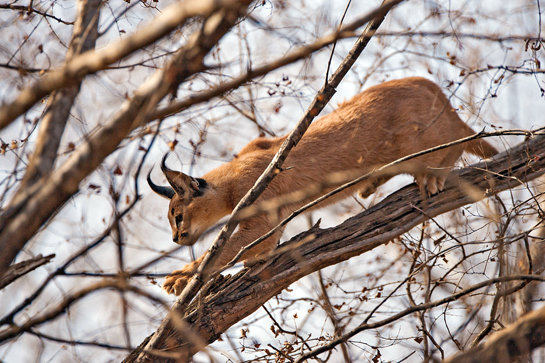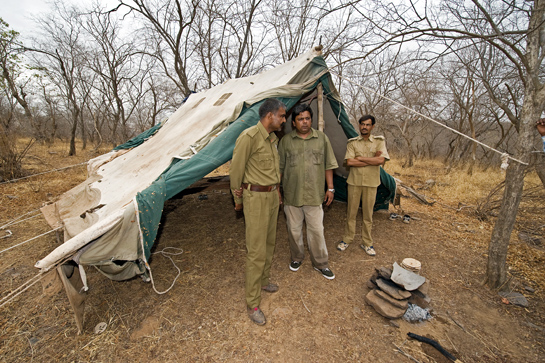Meet Aditya Dicky Singh
First published in Sanctuary Asia,
Vol. 38
No. 10,
October 2018
Declared the Sanctuary Wildlife Photographer of the Year 2011, and winner of the Carl Zeiss Award for Conservation a year later, Aditya ‘Dicky' Singh, and his wife Poonam, have run a small, iconic, wildlife lodge, Ranthambhore Bagh outside the world-famous Ranthambhore Tiger Reserve for two decades. In the process, they have become the go-to people for visitors from across India and the world in search of wildlife experiences that only those who truly know the pulse of wild India can offer. He speaks here to Bittu Sahgal, about his life's journey and about wildlife tourism, which he believes is badly in need of rescuing from the unimaginative.

Photo: Ashish Parmar
What was Aditya Singh's graph before the wildlife bug bit him?
Not very colourful at all! I was born to an army family and right up to when I was in sixth grade, I was literally transported across India with every posting of my father's. I then joined Modern School, Barakhamba Road, Delhi. My ancestors have served in the army for generations. I broke that tradition!
How did that happen?
I often ask myself the same question. I got a Civil Engineering degree from BMS College of Engineering, Bengaluru. Then, for reasons I have still not quite understood, I got into the Central Secretariat Services and found myself posted in the Government of India's Ministry of Communications. I tried. I really tried for months. And then I just had to quit because I was bored out of my skull. I met Poonam (thank heavens!) and we were married just before I quit my job (not cool!). To make ends meet, I worked as a construction contractor for two years and managed to save enough money to move permanently to Ranthambhore in 1998. The rest of the graph is still being plotted.
How come, of all things, you and Poonam chose to run a lodge in Ranthambhore?
Well, I had first visited Ranthambhore in 1984 when I finished school and stayed there for a full month, thanks to the great Fateh Singh Rathore (FSR) who my dad knew well. My residence then was the room on top of the Jogi Mahal gate, again courtesy FSR. That was it. I fell in love with Ranthambhore and would visit a few times every single year until we took our decision to make this our home in 1998.
And the lodge?
That was simple. There was absolutely no other way to make a living in Ranthambhore. The lodge opportunity sort of cropped up by magic. We got ourselves a 20-year lease in 1998 and within months the lodge was born. There were very few lodges in Ranthambhore back then, perhaps no more than six or seven!
Ranthambhore's tourism frenzy has been in the news for all the wrong reasons.
The frenzy is self-fuelling. People come here to see a tiger. When one is sighted, like bees to honey, all vehicles hone in on the spot. It's really a bad scene and I for one have no real solution. We take our guests out to the banks of rivers outside Ranthambhore on moonlit nights. We make a special effort to invite birders who actually want to be where it's quiet and other vehicles are not. But, as I said, someone who has the power and imagination has to come up with a solution to the frenzy.

Photo: Aditya Singh
Will wildlife tourism in India ever become a conservation tool?
Wildlife tourism is already one of the most powerful tools the world has for nature conservation. It's undoubtedly still at a nascent stage and is badly run. For this, both the government and the tourism operators must share blame. Right now, only a handful of species attract visitors. The experience and the freedom to roam, as we once did and which made us fall in love with nature, is just not there. The system (outside the jurisdiction of the Forest Department) promotes bigger hotels concentrated in a small area, instead of allowing small units to be set up that are spaced out and have a low footprint. You know as well as I do that many operators are in it for the cash, wildlife be blowed. Sanctuary was a major trigger for wildlife tourism in the 1980s and 90s. You should unite good people across India and hammer out a practical wildlife tourism policy for states that concentrate on delivering experiences, not just ‘come to see a tiger.
We should indeed and we will work with guys like you towards this end. Let's talk tigers for a bit. Did Panthera tigris influence the direction your life took?
Without a doubt. The first wild tiger that I saw was in Bandhavgarh. My mother is from Rewa. I was much too young to remember details, but tigers were venerated in our family. I do remember the incredible Genghis in 1984. He was responsible for getting me hooked to the wild and to Ranthambhore. Then there was Machali. The original one. On the day of Holi in 1998, Poonam saw her with her three female cubs on a sambar kill. One of those cubs grew up to be the much-celebrated Machali. In some ways, she was the catalyst that prompted Poonam and me to say, “Chalo…let's go and stay in Ranthambhore instead of crowded, noisy Delhi."
But you want things to be different here. If you were Rajasthan's Forest Minister, what would you do that has not already been done?
Well, the list is long, but nothing can work if wildlife continues to be low-priority for governments that allocate dismal budgets for protecting our most valuable resources. Having said that, tourism revenues well spent on community upliftment can easily help rejuvenate degraded areas, including lands outside parks, and sanctuaries to bounce back. If Rajasthan's designated charagas (community-grazing lands) were actually used for grazing (currently usurped by powerful farmers), great pressure would be lifted off fragile wildlife areas into which hard-pressed grazers shove their emaciated livestock. Few people realise that the lowly goats they see innocently foraging in the Aravali forests end up killing more tigers than poachers do.

Photo: Aditya Singh
You were in the middle of a storm when T-24, a male tiger, killed his fourth human. Give me a quick recount without the emotions that so distressed and divided people across India.
A male tiger called T-24 killed at least four people and ate two of them over a period of a few years. The last victims were forest guards with years of experience. All four were attacked from the back, the way tigers kill prey. Post-mortems confirmed the killing neck-bites. Eye-witnesses saw the victims being dragged and eaten. The issue is now over, except that a magnificent tiger who, in my view, should have been allowed to die with dignity in the forest itself, was tranquillised multiple times for multiple reasons and eventually found himself incarcerated for life in a zoo. People who love tigers wanted the cat to be left to roam the forest, but the authorities had dealt with retaliatory killings involving dozens of tigers in the past and decided that one more human death would push Ranthambhore back to the dark ages of human-animal conflict and they were not prepared to take that risk.
You love tigers, Dicky. I know that from the look in your eye when you see one in the wild.
Frankly, I am obsessed by all wild animals. But it's true, wild cats hold a special place in my heart. That is why neither Poonam, nor I would ever consider moving away from Ranthambhore. My occupation has gifted me the luxury of following particular tigers from birth to death. Right now, there are three tigers that have a hypnotic hold on me. Noor (T39), Krishna (T19) and Arrowhead (Krishna's daughter). I have followed the fortunes of all from birth to adulthood. A dear friend and my photography guru, Andy Rouse, and I are currently working on three books on the lives of these three tigers. The one on Noor will be out soon and we will depend on Sanctuary to help us recover the money we are spending on documenting their magnificent lives.

Photo: Andy Rouse
Count on it. Let's move geographies. Your take on the Indian wildlife experience as compared to Africa?
Africa has some very large wilderness areas, and a very low population. This enables park managers to offer visitors the freedom to roam, but for the privilege they must pay through their noses. Africa's tourism revenues are much higher and because they need to sustain fewer people, things work in their favour. India has neither the vast open wild spaces, nor sparsely-populated buffers. This is a key reason why Africa manages to use tourism revenues to fund its wildlife conservation endeavours and also share revenue with local communities. As of now in India, we have not cracked the code on this. Though I know that Sanctuary is working to do just this as we speak.
Yes, you have strongly supported Sanctuary's Community owned Community Operated Nature (COCOON) Conservancy concept.
Not because we have been friends for decades. But because you seek to rewild India by converting farms back to forest status by making communities owner-partners in conservation. While farmers working on the margins of wildlife areas can barely eke a living out for themselves, they manage to cause a lot of harm to biodiversity through the use of pesticides and by clearing forest lands. Turning farms to forests in ways that profit landowners is a win-win all round. A no-brainer.
Wildlife photography? Is there a future for photographers in India?
A very bright future… as a hobby! As a profession, it is going through turmoil across the globe and in India you would be hard put to find more than a handful of wildlife photographers who earn their keep from their own images. Ethically, while we do have our black sheep, wildlife photography has done a great service for conservation by drawing attention to the value of our heritage. Most people in cities have only seen animals in zoos and to see them wild and free has now become an aspirational thing. The gate money paid by tourism, which almost inevitably incorporates photographers, be they amateurs (in hordes) or professionals (too few), funds conservation. At least in Ranthambhore, I know that to be true. But if you ask me, the real future is in videos. The Internet has created the demand and, apart from the BBC and National Geographic and other international wildlife channels, when videos go viral, there is the possibility of earning money for those who invest in equipment and on travel, lodging and the every-rising gate fees.
It's been 20 years that you and Poonam have been here in Ranthambhore. Are things better or worse?
There is no easy answer to that. We have much fewer cattle. Tiger habitats here are expanding, not contracting. But so is the possibility of conflict in the periphery. Perhaps if Sanctuary's idea of Community Owned Community Operated Nature Conservancies works out and marginal/failed farms in the periphery turn into wildernesses, conflict will come down, wild populations from natal areas might have space to expand into and poachers will have a tougher time to convince villagers to lay traps, poison waterholes or use electricity to kill wildlife. If this happens, and I believe it can, my answer 20 years from today will be much more positive.
Any advice to young photographers with stars in their eyes?
Stay with it. It takes a fair amount of time to get good pictures consistently. Making mistakes is the best way to learn. Take time to practice. It is critical that newbie photographers understand that before learning about their cameras and Photoshop, they need to learn about wildlife. Not just animal behaviour, but conservation issues including threats, social impacts, the difficulties faced by park managers, how corridors can help cores and buffers get better and much more. The future lies in conservation photography, which involves pure art, technique and, yes, even Photoshop to (ethically) get the best out of your RAW images. Just going out with a camera on safaris is like buying your way into a peep show. It might momentarily tickle your curiosity, but after a while it will leave you frustrated, with no deeper understanding, happiness or satisfaction.

Photo Courtesy: Aditya Singh
Your advice to young folks wanting to start a wildlife lodge…
It's not as tough a business to set up as you might imagine, but it is a tough one to sustain over a period of time. Build a reputation for ethics. Never cheat. Never take shortcuts. And positively don't get into it as a pure investment for yourself (leave that to others who wish to invest in your venture!). If you don't love the wild, choose to do something else.






